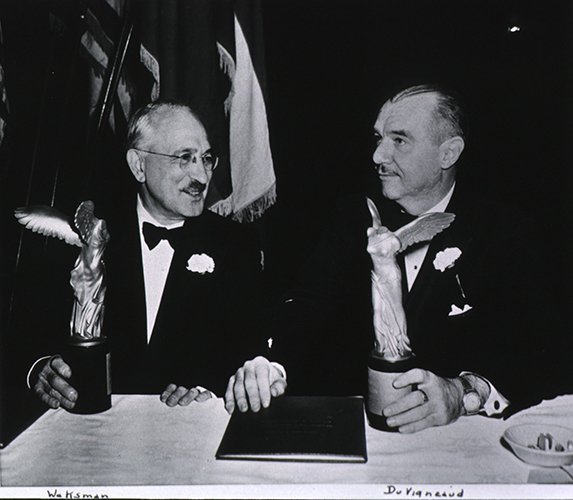Microbial antagonisms and antibiotic substances. New York: The Commonwealth Fund, 1945.
 Ukranian-born American biochemist/microbiologist Selman Waksman immigrated to the United States from Russia in 1910 after being refused acceptance into college because of anti-Semitism. He received both B.Sc. and M.Sc. degrees from Rutgers University, and in 1918, he received a Ph.D. in biochemistry from the University of California. Upon completing his doctorate, Waksman returned to Rutgers and eventually became a full professor of soil microbiology in 1930. He held several other faculty positions at that university throughout the remainder of his career, including chairman of the microbiology department and director of the Rutgers Institute of Microbiology.
Ukranian-born American biochemist/microbiologist Selman Waksman immigrated to the United States from Russia in 1910 after being refused acceptance into college because of anti-Semitism. He received both B.Sc. and M.Sc. degrees from Rutgers University, and in 1918, he received a Ph.D. in biochemistry from the University of California. Upon completing his doctorate, Waksman returned to Rutgers and eventually became a full professor of soil microbiology in 1930. He held several other faculty positions at that university throughout the remainder of his career, including chairman of the microbiology department and director of the Rutgers Institute of Microbiology.
As a soil microbiology specialist, Waksman made it his goal to find what he called “antibiotics” in the soil micro-organisms called antinomycetes. In 1940, Waksman isolated an antibiotic called actinomycin from antinomycetes. Though actinomycin was effective in killing bacteria, it was toxic when used on animals. Although this made it unusable, the discovery of this antibiotic led Waksman in the right direction, and a few years later, he isolated streptomycin from another species of antinomycetes, Stretomyces griseus. This antibiotic had low toxicity, and Waksman found that it was useful in fighting tuberculosis (Porter 457-458). Tuberculosis had been the most significant cause of adult death in the late nineteenth century, but a vaccination developed in the 1920s reduced the disease’s spread (Duffin 157). However, Waksman’s antibiotic, along with chemotherapeutic treatments, helped to drastically reduce tuberculosis mortality in the twentieth century. He received a Nobel Prize for his discovery in 1952.
Waksman and his associates went on to extract several other valuable antibiotics from soil microorganisms. His 1945 book, Microbial antagonisms and antibiotic substances, is an in-depth study of the relationships of microorganisms, especially their antagonistic tendencies which aid in disease treatment (Waksman, Microbial antagonisms, viii). Though soil was Waksman’s primary research focus, it is not the only medium for microorganisms discussed in this book. The Reynolds-Finley Library holds a first edition copy of Microbial antagonisms and antibiotic substances.
Britann. Guide to the Nobel Prizes, Chambers, Concise Dict. Of Scientists, p.392; Duffin, Hist. of Med., pp.157, 159-160; Porter, Greatest Benefit to Mankind, pp.457-458; Rutgers University Archives and Special Collections; Reynolds Historical Library, Rare books and coll., Vol. 2, 2-1797.
Image: Selman Waksman, Pictured on the left, Courtesy of the National Library of Medicine.
